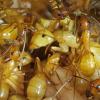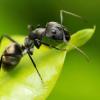Acutus, it is wise to hold off on harvesting in the first year of beekeeping. There is a LOT of observation and learning to do, first. If you started from packages, it is very unlikely that you would have any real harvestable amount, anyway. I've bought a lot of packages through the years, and very rarely do they produce excess in their first year (they MAY produce just enough for themselves to overwinter, but it's not wise to take that). Nucleus colonies, on the other hand, can be quite a different story. Sometimes nucs will explode and easily make enough to harvest... A lot has to do with how good the bloom is, how strong the nucleus colony is, and how good the genetics are. We bought nucs from a guy in South Carolina for the last couple of years prior to this year...a total of about sixteen (eight per year), and some of them did decently well in their first year, some seemed queenless when we bought them, and some fizzled out and we ultimately had to start over with them. Those nucs cost $145 ea. This past season we went back with a nuc-maker (we bought six) who also happens to run the UGA beelab and heads a lot of the research there (incidentally, she also is part of the national initiative to improve the breeding pool via artificial insemination from drone semen from overseas because the US does not allow bees to arrive from out of country). Her nucs are ridiculously strong when you get them, the Carniolan/Russian genetics are slightly on the mean side, and if you don't upsize them to a ten-frame deep immediately and at least a ten frame medium a week after, they ARE GOING TO swarm. They work so quickly that despite giving them excess space, they still made swarm cells immediately. For three weeks during the heaviest part of the flow, we had to go into each hive frame-by-frame and destroy queen cups and uncapped cells. TEDIOUS...BUT, those hives each pulled a deep and a medium at least. We pulled three extra supers from two of those hives this past Friday of three in the apiary. There are three more of those upsized nucs that are in different apiaries, and at least two of them have produced excess honey that will be pulled and extracted. The drawback to these colonies is the initial cost of $190 ea. However, based on the amount of honey that has already come from two in a single season--nine gallons so far--they will pretty much pay for themselves by the end of spring. If the fall flow does anything at all, they will begin to turn a profit (I know that's a new swear word, but I don't live in fantasy land) after having them for seven months. THAT is how I determine "good" or "bad" nucs. That $190 hurts, but if you know how to handle and arrange such fast bees, they'll make it back and then some before you've had them for a year. If you're truly new and have zero experience with nucs, I see a lot of people buy high quality nucs and lose them because the beek wasn't fast enough to stop the swarming.
AntPhyco, do you know what your primary flows come from? In the spring we have a lot of crimson, and white dutch clover types. Our spring flow is usually a mix of: clovers, Nyssa genus trees (if your apiaries are near swamps or floodplains, anyway), American holly trees, blackberry blooms, and privet. Those are the heaviest contributors to the honey that's put back. Our bees build on different blooms at the earliest part of spring, but that nectar is usually converted to brood and wax long before is gets ripened into honey.
Edit: "Nuc" is just short for "nucleus colony". A nucleus colony is just a small/whole bee colony with varying stages of brood, a laying and accepted queen, a few thousand workers, and a couple of food frames (honey and pollen). The traditional nuc is a five deep frame colony, and that's what we typically buy when we buy bees.
Edited by Nylanderiavividula, May 27 2019 - 3:47 AM.

















